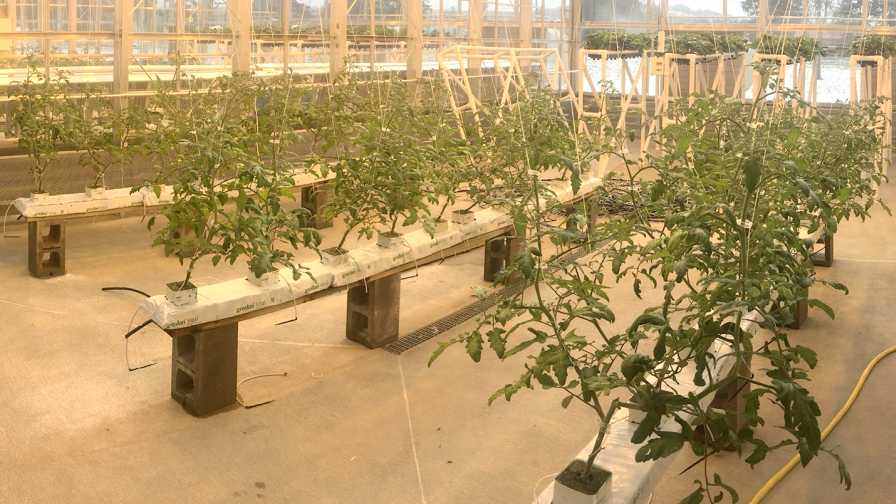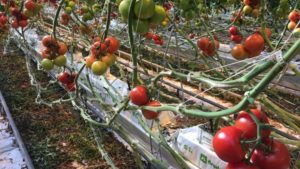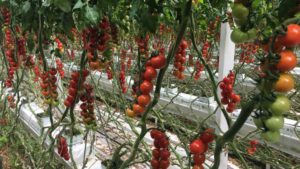Learn the Basics of Greenhouse Tomato Crop Steering

A young tomato crop in a vegetative growth phase. Photos: Cornell University CEA Program
The primary goal of any greenhouse tomato grower is to maximize the productivity and longevity of their plants to produce the highest yields for the longest time possible. Managed well, a tomato plant can yield fruit for nine months, but to achieve both maximum productivity and longevity, a careful balance between generative growth (fruiting biomass) and vegetative growth (non-fruiting biomass) must be found over the crop’s lifecycle. Steering the crop using environmental controls has emerged as the most popular way to find this balance.
In general, crop steering is the use of environmental controls (predominately abiotic factors) to achieve a certain growth profile in your crop — generative or vegetative. Steering the crop towards generative growth tells the crop to allocate its energy towards fruit production, whereas steering the crop towards vegetative growth tells the crop to put its energy towards non-fruiting biomass production like stem and leaves.
While it may seem advantageous to steer the crop far towards generative to produce high yields, in actuality the crop will quickly run out of energy without an adequate balance of vegetative growth, which allows the crop a chance to recharge its batteries to sustain growth and productivity throughout the season. Steering the crop too far on the road to generative growth will cause the plants to be small and susceptible to breaking, disease, and stress. Additionally, steering the crop too far in the direction of vegetative growth will cause the plants to grow excessively with much of the plant’s energy going to unproductive lateral branches and leaves versus fruit. To avoid swinging too far in one direction, it is crucial to carefully observe the crop’s growth and adjust as necessary.
Monitoring Plant Development
To get a good idea of how the crop is behaving, detailed measurements should be taken on a daily and weekly basis. It is a good practice to monitor one block of plants — the block could be one slab, for example — in each zone of the greenhouse, with a zone being any section of the greenhouse that has its own separate controls over lighting, temperature, humidity, and/or irrigation. Measurements such as weight of clusters, internode length (distance from apical meristem to first leaf), weekly growth, head width (stem diameter below youngest flower cluster with an open flower), and number of leaves can give a clear picture of how the crop is growing over time. Other measurements that should be taken are day, night, and 24-hour average temperatures, Electrical conductivity (EC) drip and EC drain measurements, irrigation start and end times, and irrigation rate. Knowing this data helps give the grower a starting point to then modify the environment to steer the crop in one direction or the other.

This healthy tomato-on-vine (TOV) crop is in a generative growth phase.
There are many guides and resources that give detailed recommendations on when and how exactly to steer a crop; however, in simple terms, adding stress to the crop will steer its growth towards generative, and removing the stress will steer it towards vegetative. For example, to go from vegetative to generative, the grower could increase the 24-hour average temperature, increase time between each watering (aka, increase the dry-back period), increase the EC of the drip irrigation, increase the difference between day and night temperatures, or increase the day to night cooling rate. Each of these changes will cause stress to the plant and thus cause the plant to allocate more energy to fruit production.
Pruning of flowers, fruit, leaves, and suckers could also be considered ways to steer the crop in the direction of generative growth, as it reduces the total energy going to non-yield related biomass. Additionally, another common steering practice is to adjust the fertilizer recipe. At first lower nitrogen is used to steer tomatoes on their way to generative growth. As the plants begin to fruit, nitrogen concentration is increased as is calcium and potassium to meet the greater nutrient demands of the fruiting plants.

Healthy cherry tomato plants in a generative growth phase.
Why Steering Should Be Gradual
Due to a wide variety of variables that growers face as a result of climate, latitude, and other factors that influence crop growth, abiding by a set schedule for crop steering is often unrealistic. However, growers will typically focus entirely on vegetative growth until the first fruit or until the crop is of a certain size. After this point, growers aim to maximize generative growth and thus yields; however, the crop will need to be steered back towards vegetative if the crop begins to show nutrient deficiencies, slowed plant growth, reduced fruit sets, smaller fruit, or if the grower decides to increase the crop density, which is a large stress to the plant. In general, once a grower determines the crop is ready to be steered, it is important to make gradual changes to see how the crop reacts, then either continue or steer in the other direction if necessary. The further the crop is swung in one direction, the harder it is to get back on track.
Crop steering is a delicate process that requires the grower to keep a very close eye on the crop’s growth at all times. The better the grower understands their crop, the better they will be able to control its growth. While this level of attention takes time and effort, the results can have a huge impact on yields and longevity of the tomato crop.
This article is the first in a 2021 Cornell University CEA Grower Series featuring research from students in Cornell University’s Controlled Environment Agriculture (CEA) program. Learn more at cea.cals.cornell.edu.










